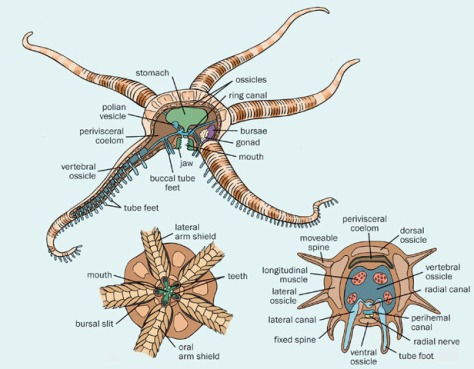Some month ago, we talked about starfishes and we said that there are some animals, which are also echinoderms, with which they can be easily confused. Well, in this post we will talk about these animals: the brittle stars. We are going to explain their features to distinguish them from starfishes and we are going to expose some Mediterranean species.
THE BRITTLE STARS
The brittle stars or ophiuroids are a class of echinoderms with more than 2,000 living species, which live in all types of seafloor.

What features do you have to pay attention to differentiate a brittle star from a starfish? Brittle stars have five arms, which are thin and sharply originate from the central disk. This feature is key to not confuse them with starfishes. Another characteristic you have to observe to differentiate brittle stars from starfishes is in the bottom (oral side) of the animal: the ambulacral grooves are closed and covered by plates. Furthermore, tube feet don’t have suckers because they are more involved in locomotion than in feeding. In fact, their arms are constituted by articulated ossicles (called vertebrae) that allow their displacement.
Having the arms so thin, where are their organs? The mouth is in the lower part of the body and is surrounded by plates acting as jaws. They have no anus, so products that are not digested are expelled through the mouth. All organs are located in the central disc. They use bursae to breathe, which are bags in which water enters and leaves. In addition, the reproductive organs are connected to these bags, so that they expel gametes with water (although some species incubate their offspring). Most species have separate males and females.

Where can you observe brittle stars? Brittle stars normally live in rocky seafloor with low or without light, usually hidden in cracks, where they feed on suspension particles, but some of them are carnivorous and one species can catch fishes by using their arms as a cage.
SOME EXAMPLES FROM THE MEDITERRANEAN SEA
In the Mediterranean Sea, we can find about 34 brittle star species. Six of them are endemic and other 2 species are exotic. Here, we will explain 5 of them.
SMOOTH BRITTLE STAR (Ophioderma longicauda)
It is the largest species. It comprises a pentagon-shaped central disc (about 3 cm of diameter) with arms, which are a bit bony and are 15 cm long. It has a brown colour on the dorsal side and is lighter in the ventral side and arms. They can be find till 50-70 meters deep under rocks, in holes and cracks; but the young individuals can hide between seaweed. They feed on worms and bivalves, mainly during the night.

COMMON BRITTLE STAR (Ophiothrix fragilis)
Common brittle stars have the whole body covered with long spines, which can take a variable colour (usually brown and grey tonalities). They can measure up to 12 cm. It is the most abundant in both hard and soft bottoms, up to 100 meters deep. It feeds on particles with the ambulacral system. Did you know that they can live about 10 years? A curiosity: if you take one of these brittle stars and let it fall to the bottom, it sinks with open arms, allowing you to distinguish it from the following species.

BLACK BRITTLE STAR (Ophiocomina nigra)
Although it is similar to the previous species, it can be distinguished from the common brittle star by the fact that in this species the spines are only in the arms, are shorter and are laterally arranged. It also has a brown to black colour, while arms are lighter than the disk (measuring up to 2.5 cm in diameter). It lives in shallow, rocky and sandy areas. To differentiate it from the common brittle star, if you catch one of them and you let the brittle star to drop, the ophiurid sinks with arms folded upwards.

AMPHIURA CHIAJEI
It is a small brittle star, with his body normally buried in the mud, so that only shows the arms abroad, which are very long and are used to collect debris. Its color is orange red. It is usually found between 10 and 200 meters deep.

ASTROSPARTUS MEDITERRANEUS
This brittle star can not be confused with any other: it has its entire body covered with granules and has a considerable size. It is of uniform grey colour. They live in deep rocky substrates, sedimentary continental shelf and over gorgonian between 50 and 200 meters deep.

REFERENCES
- Ballesteros E & Llobet T (2015). Fauna i flora de la mar Mediterrània. Ed. Brau
- Club de Buceo de Biología: Ophiocomina nigra
- Club de Buceo de Biología: Ophioderma longicauda
- Club de Buceo de Biología: Ophiothrix fragilis
- Coll M, Piroddi C, Steenbeek J, Kaschner K, Ben Rais Lasram F, et al. (2010) The Biodiversity of the Mediterranean Sea: Estimates, Patterns, and Threats. PLoS ONE 5(8): e11842. doi:10.1371/journal.pone.0011842
- Hichman, Roberts,Larson, l’Anson & Eisenhour (2006). Principios integrales de Zoología. Ed. McGraw Hill (13 ed).
- Martin P (1999). Claves para la clasificación de la fauna marina. Ed. Omega
- Riedl R (1986). Fauna y flora del Mar Mediterráneo. Ed. Omega
- Vàzquez, J & Maluquer-Margalef, J (coord.) (2014). Guia pràctica per conèixer la natura de Catalunya. IPCENA. Lleida. 576 p.
- Foto de portada: Animal Base



One thought on “They look like starfishes, but they aren’t: the brittle stars”